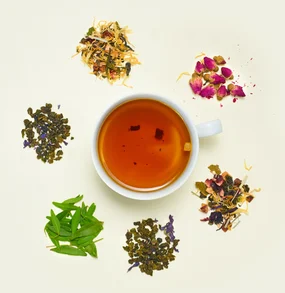
Kleinburg Integrative Health:
Articles
Articles

Tips and Home Remedies to
Help Fight Cold and Flu
by Sarah Tayebi,
Naturopathic Medicine Graduate
December 2020

What we should eat?
Diet and Supplements
Our main dietary objectives during cold and flu are consuming highly nutritious and easy to digest foods and avoiding any mucus-forming foods and overeating.
Specific dietary recommendations are:
- Increase fluid intake. Not only water intake but also nutritious liquids such as bone and chicken broth, vegetable juice and herbal teas.
- Add natural antibiotic foods such as garlic, onion and ginger. They could be added as a crashed or juice in foods or teas.
- Add warming foods such a ginger, chili, thyme and sage. They could be added as a crashed or juice in foods, or teas.
- Exclude: dairy product because they produce excessive mucus. And sugar because it suppresses the immune system.
- Avoid hot, greasy, pungent, dry, cold and fatty foods.
Tips & Recipes
A warming drink
Fresh ginger root sliced with raw or manuka honey, cinnamon quills, lemon juice, +/− fresh chili, onion chops and garlic in hot water will encourage the diaphoretic effect and assist in the body’s ability to naturally eradicate the infection.
Bone broth
Homemade bone broth can be effective in helping to fight colds and flus. Bone broth is very easy to digest and a rich source of essential amino acids and minerals that could provide our body with the energy ,macro and micro nutrients needed for recovering rom cold and flu.

Ingredients (4 servings):
- 2 lbs of chicken bone
- 1 Carrot (peeled and chopped)
- 1 medium Onion (diced)
- 2 stalks of Celery (chopped)
- 3 Garlic (cloves, halved)
- 1 tbsp Apple Cider Vinegar
- 1 tsp Sea Salt
- 1 cup Parsley (chopped)
- 6 cups filtered Water (or enough to cover bones)
Directions;
- Place the bones in the slow cooker. Add all remaining ingredients. Set slow cooker on low and let cook for at least 12 hours.
- After 12 hours, strain the broth through a strainer or mesh sack. Discard the vegetables that you strained out. Allow broth to cool. Once cool, remove the layer of fat that forms on the top and discard. Freeze broth until ready to use.
- For making a healthy and nutritious bone broth, organic meat and vegetables are preferred .
Herbal Teas
- Elderberry tea = antiviral & immune support)
- Echinacea tea (antiviral & immune support)
- Elderflower tea (natural decongestant)
- Sage tea
- Licorice root tea
Vitamin C
When it comes to cold and flu, vitamin C is the most famous supplement and there is lots of conflicting information out there . Is vitamin C effective or not? A 2013 Finland study of 11,306 individuals found that vitamin C was shown to reduce the duration of colds, but to a greater degree with higher doses.2 Vitamin C has been shown to be the most beneficial in the context of stress, low dietary intake of vitamin C, elderly and in children. The maximum amount of vitamin C a person can absorb is limited by bowel tolerance If you begin experiencing any diarrhea, nausea, or upset stomach then you have reached bowel tolerance. Start with 1000mg of vitamin C and take 1000mg every few hours until bowel tolerance.
Zinc
Some studies demonstrated that zinc (20-60mg/d) within the first 24 hours of symptoms and continuing until symptoms resolve may reduce symptoms or duration of sickness by almost 50%.5 Zinc supplementation may be a concern in some patients, for any zinc supplementation over 30 mg/d for more than 5-7 days consult with your naturopath.
Exercise and Physical Activity
Ensuring adequate rest is a key when your body is fighting with viruses or bacteria, however, a mild exercise could be acceptable if you don’t have chest congestion, hacking cough, fatigue, moderate to sever muscle aches or fever.
How to Reduce Nasal Congestion?
Wet socks
Using “wet socks” is a traditional method to reduce fever and cold symptoms of head and face such as nasal and sinus congestion.
How does it work?
The heat from the hot water makes blood vessels expand and the cold water makes them shrink ( constrict).this expansion followed by constriction act like a pump and helps with better blood movement .
What do you need?
- A bucket of water as hot as you can handle it without burning your skin.
- A pair of cotton socks.
- A pair of woolly socks.
Instructions:
- Before you go to bed, wet your cotton socks in a very cold water, as cold as you can handle it and wring the socks out.
- Put your feet in the bucket of hot water for at least 3 minutes
- Put on your cold socks immediately after your hot foot bath.
- Put on your wool socks and go to bed.
- Leave the socks on until they are dry, it usually takes until morning.
Nasal Irrigation
A neti pot can be used to rinse mucus from the nose and are available in pharmacies, health food stores and online. Below is a quick outline of the process:1
- Use sterile distilled bottled water, or;
- Tap water that has been filtered using a filter of 1-micron size or smaller or boiled for several minutes and left until lukewarm.
- Tilt head sideways over the sink and place the spout of the neti pot in the upper nostril. Breathing through your open mouth, gently pour the saltwater solution into your upper nostril so that the liquid drains through the lower nostril. Repeat on the other side.
- Rinse neti pot after each use with similarly distilled, sterile, previously boiled and cooled, or filtered water and leave open to air-dry.
Red Flags
 A common cold and flu may usually last 2 weeks until all symptoms resolve. Contact your health care provider in case of experiencing any of the following symptoms:
A common cold and flu may usually last 2 weeks until all symptoms resolve. Contact your health care provider in case of experiencing any of the following symptoms:
- Fever > 39.
- Altered Consciousness.
- Unexplained skin rash.
- No improvement after a week.
- Worsening of symptoms after 48 hours.
- Rapid progressing symptoms.
I hope you enjoyed this article.
Please let me know if you need help or have additional questions.
Sarah Tayebi
Naturopathic Medicine Graduate
References:
What is a neti pot? And why would you use one?. Answer From James T C Li, M.D., Ph.D. Retrieved from: https://www.mayoclinic.org/diseases-conditions/common-cold/expert-answers/neti-pot/faq-20058305
Cochrane Database Syst Rev. 2013 Jan 31;(1):CD000980. doi: 10.1002/14651858.CD000980.pub4.
Cochrane Database Syst Rev. 2000;(2):CD000980.
H Hemila, E Chalker, et al.: Vitamin C for preventing and treating the common cold. Cochrane Database Syst Rev. (1)2013 CD000980
M Hirt, S Nobel, E Barron: Zinc nasal gel for the treatment of common cold symptoms: a double-blind, placebo-controlled trial. Ear Nose Throat J. 79 (10):778-780 2000 782 11055098
Background photo created by freepik – www.freepik.com/photos/background
Food photo created by KamranAydinov –https://www.freepik.com/photos/food
Food photo created by master1305 –https://www.freepik.com/photos/food





